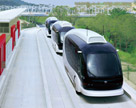Profile of the IMTS at EXPO 2005 AICHI, JAPAN

The following is a description of the Intelligent Multimode Transportation System (IMTS) you are going to be riding today.
The IMTS was created with technical assistance from Toyota Motor Corporation, which developed and deployed the vehicles and system. The construction of a dedicated on-site road (the IMTS EXPO Line) and operation of the system were headed by the Japan Association for the 2005 World Exposition.
Applying the latest intelligent transport system (ITS) technology, the IMTS is a new transport system allowing unmanned, automatic, and platoon operation on the dedicated road, and manned, independent operation like ordinary buses on ordinary roads. It features the punctuality, high speed, and transportation capacity of conventional railway mass transit systems such as trains as well as the economic merit and flexibility of routed buses. And for passengers, it offers the convenience of not having to make a transfer from a train to a bus.

Major features
1) Vehicle design
Advanced form that gently embraces passengers, inspired by the image of a sprouting bud, with a curved glass cabin affording a panoramic field of vision
2) Vehicle structure
Use of a light-weight but high-hardness carbon composite monocoque bodies
3) Operation
Unmanned automatic operation in platoons (with an attendant riding on the lead vehicle) on the dedicated road and manned manual operation on the ordinary road (on-site road for administrative use) after the last vehicle automatically switches to it.
4) Environmental measures
Mounted with engines fueled with clean compressed natural gas (CNG)
Operation plan
1) Service zones
Automatic operation zone
IMTS dedicated road connecting the North Gate Station, West Gate Station, and EXPO Dome Station, for a total one-way distance of about 1.6 kilometers
Manual operation zone
Administrative on-site road connecting the West Gate Station and the (Morizo& Kiccoro) Convention Hall Bus Stop, for a total distance of about 0.8 kilometers
2) Number of units
13 in all (four platoons consisting of two or three units each)
3) Operating speed
About 30 kilometers per hour at maximum and 20 kilometers per hour on average
4) Terminal-to-terminal traveling time
About 10 minutes (minimum one-way time in the automatic operation zone)
5) Operating interval
Automatic operation zone
About 10 minutes (six platoons per hour)
Manual operation zone
About 40 minutes (one or two platoons every hour)
6) Passenger volume (estimated)
Automatic operation (round-trip)
18,400 people per day
Manual operation zone (round-trip)
1,500 people per day
Outline of the IMTS, a next-generation transportation system
IMTS features
Adjustable capacity
Ability for flexible operation in correspondence with fluctuation in demand due to the platoon operation of units that are not physically linked
High speed and punctuality
Attainment of speeds and punctuality on a par with advanced transport systems due to operation over a dedicated road
Excellent multiple-modality
Achievement of transportation with little transfer due to the dual-mode operation
Route flexibility
Ability to set routes flexibly due to the flexibility in combination of dedicated and ordinary roads and superiority to conventional trains in respect of minimum turning radius and grade-climbing ability
Outstanding economic merit
Substantial savings of construction and maintenance costs due to the lack of need for rails and transformer facilities as well as the compactness of the control system and vehicle terminals; substantial savings of labor and related costs as well due to the unmanned operation over the dedicated road
Outline of the IMTS system
IMTS vehicles are steered and controlled by magnetic markers imbedded in the middle of the dedicated road. High levels of safety and dependability are assured by the automatic speed control and braking functions resting on inter-vehicle communications, ground signal units, and other such devices.
Lane-keeping function
Automatic steering and control based on magnetic markers imbedded in the surface of the road in its center
Platoon operation function
Operation in a file without physical connection (through electronic linkage)
Speed-maintenance function
Automatic control of speed, including stops and starts, in accordance with the operation timetable
Fixed-point stopping function
Sure stopping of each vehicle at fixed points on the platform
Anti-collision function
Automatic braking control by means of inter-vehicle communications, ground signal units, and other devices
Major specifications
Vehicles
| Total length x total width x total height (mm) | 10,910 x 2,490 x 3,870(including antenna) |
| Maximum number of passengers | 50 |
Engines
| Displacement (cc) | 10,520 cc |
| Fuel | Compressed natural gas |
| Maximum output kW(PS)/rpm | 169 kW (230 PS)/2100 rpm |
| Maximum torque Nm(kgm)/rpm | 883 Nm (90 kgm)/1100 rpm |


